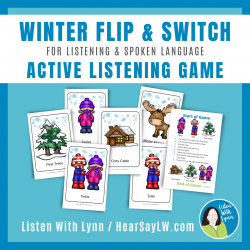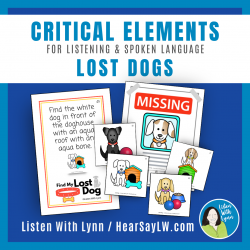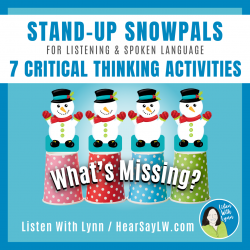Ability Levels
Categories
Resource Types
Age/Grade Range
CCSS
Anchor Standard
Speaking & Listening
Language
Reading
LISTENING DETECTIVE - Defining and Describing Game
$ 7
Kids listen, grow and practice using descriptive vocabulary while expanding complex language skills when playing LISTENING DETECTIVE. Players take turns describing and identifying objects on a colorfu
...
l and engaging game board.➼ The Describer gives the descriptions to the other player(s) targeting expressive language skills. They describe exactly with their words. Acting out is not allowed.➼ The Detective listens to descriptions, creates a picture in their mind then identifies the object targeting auditory comprehension, memory skills, and critical thinking.Teletherapy | Distance Learning | At HomeGOOGLE Drive, DIGITAL AND PRINTABLE! Includes a zipped file that contains✤ A guide and handout for parents, teachers, and therapists with prompts aimed at expanding vocabulary using descriptions and definition✤ Listening and Spoken Language (LSL) Tips for gameplay✤ Digital Game board✤ Printable Game board✤ Link to access Game board through GOOGLE Drive™Teletherapy, Distance Learning & Face to FaceListening Detective can be - ✧ Printed to play at home or in face-to-face sessions.✧ Played using Google Slides™ on a desktop computer, SmartBoard, or teletherapy platform.✧ Played using the interactive PDF on a computer, iPad or teletherapy platforms using PDF reader apps such as the free Adobe Reader DC . In teletherapy, open the PDF, then screen share that window into the teletherapy platform. Use free annotation tools to play.You will need a Google account to access this game in Google Drive!If you want to assign this product to Google Classroom, your students will also need a Google Account.Make a copy for each student.✤ To restore to the original version go file ➼ click the original version to reset for the next gameplay.
Language - Adverbs - Gently, Merrily, Down the Stream!
$ 295
Describes how adjectives help us more clearly visualize the action in a sentence. Includes adverb book lists, activities, adverb word bank, Tom Swifty jokes with adverb punchlines, and 8 worksheets to
...
develop use of adverbs in speech and writing. Gives an adverb rubric and sample IEP goals.
WINTER Active Listening Direction Game Flip & Switch
$ 5
WINTER Flip & Switch is a fast-paced listening, language, and following-direction game. Flip & Switch is fun for the kids and easy for you! It's an easy one-time prep to use over and over year after y
...
year.Players listen and move, flip and switch the two-sided game cards. There are six sets of sequential auditory directions that feature the spatial concepts - next to, over, below, above, left, right, and switch. When followed exactly they end with a rewarding self-check confirmation.. IDEAL FOR:Listening & Spoken Language, Deaf & Hard of Hearing, Auditory Verbal Sessions, Speech and Language Therapy, Auditory Processing, Special Education, Home ActivitiesYOU CAN TARGET:Following auditory directions - easy to complex.Understanding descriptions involving spatial concepts.: next to, over, below, above, left, right, and switch.Auditory working memory, auditory processing, comprehension, and executive functioning.THE GAME INCLUDES: • 6-Playing Cards Winter themed• 6-sets of multi-step auditory directions that increase in complexity • Pre-game expansion suggestions• Listening and Spoken Language (LSL) TipsCUSTOMER TIPS:➼ Questions? Email me before purchasing this resource or anytime later.♥ Sign-up HERE for the Listen With Lynn Newsletter♥ For more ideas visit my blog: HearSayLW.com♥ Let’s Connect:InstagramFacebookKeep up your good work. I am blessed to help along the way. Lynn
HALLOWEEN DOGS Listening for Critical Elements Directions & Descriptions
$ 7
HALLOWEEN DOGS is an engaging following-direction game with critical elements that get kids listening and engaged. Kids love the delightful dogs in costumes that challenge auditory working memory, com
...
comprehension, and auditory processing speed. The game uses descriptions that boost critical thinking, executive functioning, and communication skills.HALLOWEEN DOGS is a flexible game where you can play using all the cards, sort out a smaller set, or simplify the directions. It is easy to level up or down the directions to meet a child’s needs and goals.HALLOWEEN DOGS is effective for all children and outstanding for kids who are deaf and hard of hearing and who struggle to recall longer sentences or remember only part of the information that was said. A child’s capacity to listen, remember, and recall impacts their ability to follow complex instructions, understand detailed conversations, and learn new information.INCLUDES:✤ A Huge Resource of 78 playing cards✤ 36 Halloween Dog picture cards✤ 36 description/direction cards✤ Six Game Mats✤ A set of PRINTABLE game cards✤ A DIGITAL game board✤ Data Collection Sheet✤ A Guide with instructions ✤ Listening and Spoken Language TipsFACE TO FACE - TELETHERAPY - HOME✢ PRINT - One-time easy prep. Print and cut out the Halloween Dog picture cards, the description/direction cards, and print the 6 game mats✢ DIGITAL - Screenshare the gameboard with your favorite PDF reader such as the free Adobe Acrobat Reader DC. Read the descriptions and the listener marks the dogs using the annotation tools.◈ ◈ ◈ ◈ ◈ ◈ ◈ ◈ ◈ ◈ ◈ ◈ ◈ ◈ ◈ ◈ ◈ ◈ ◈ ◈ ◈ ◈ ◈ ◈ ◈ ◈ ◈ ◈ ◈ ◈CUSTOMER TIPS❤ Sign-up HERE for the Listen With Lynn Emails➼ Questions? Email me before purchasing this resource or anytime later.❤ Let’s Connect:InstagramFacebookKeep up your good work. I am blessed to help along the way. Thanks so much!Lynn
WARM & WOOLY Description and Attribute Game
$ 4
Warm & Wooly is a delightful winter-themed listening and language game designed to engage children in identifying and describing festive, colorful sweaters based on their unique attributes. Perfect fo
...
ect for two players or team play, this game puts a seasonal spin on the classic guessing game by encouraging players to ask strategic yes-or-no questions to narrow down and pinpoint the correct sweater.Warm & Wooly naturally strengthens essential skills such as listening comprehension and logical reasoning, while also targeting key auditory goals. Players practice auditory processing, memory (by recalling clues), and inferencing skills—all while building their descriptive vocabulary in a fun and engaging way.One key focus of the game is practicing morphological word markers of the auxiliary verbs - is/are, do/does, and also negatives and contractions. These grammatical elements are often embedded in connected speech, are high-frequency, and difficult to hear for individuals who are deaf and hard ofhearing.Whether in a therapy session, a school lesson, in the classroom or at home, Warm & Wooly makes learning festive, interactive, and memorable for kids.★ NO-PREP - N0-PLANNING★ DIGITAL and PRINT & GOINCLUDES:✤ Four game boards with eight festive sweaters each✤ Two advanced boards with 16 sweaters each✤ A set of PRINTABLE game boards✤ A set of DIGITAL game boar✤ A Guide with instructions ✤ Listening and Spoken Language TipsFACE TO FACE - TELETHERAPY - HOME✢ PRINT - One-time easy prep. Print and go✢ DIGITAL - Screenshare the gameboard with your favorite PDF reader such as the free Adobe Acrobat Reader DC. Read the descriptions and the listener marks the dogs using the annotation tools.◈ ◈ ◈ ◈ ◈ ◈ ◈ ◈ ◈ ◈ ◈ ◈ ◈ ◈ ◈ ◈ ◈ ◈ ◈ ◈ ◈ ◈ ◈ ◈ ◈ ◈ ◈ CUSTOMER TIPS❤ Sign-up HERE for the Listen With Lynn Emails➼ Questions? Email me before purchasing this resource or anytime later.❤ Let’s Connect:InstagramFacebookKeep up your good work. I am blessed to help along the way. Thanks so much!Lynn
LINK IN A WINK VOCABULARY and ATTRIBUTES Listening, Language Game
$ 6
LINK in a WINK is an exciting fast-paced vocabulary game designed to support listening and spoken language development. Kids love this fun, easy-to-play game, all while expanding their vocabulary, lea
...
, learning attributes, and practicing categories, associations, auditory memory, word retrieval, and turn-taking skills.This game also strengthens important cognitive abilities, such as working memory, abstract reasoning, and cognitive flexibility, especially for children who are deaf or hard of hearing.★ No Planning! One Time Print. Then Grab-N-Go!★ Use all year round and year after year!The Object is to listen and be the first to find a PICTURE card from their hand that matches the ATTRIBUTE word or phrase.HUGE RESOURCE! What’s Included:✧ 100 Attribute Cards✧ 120 - 60 Two-Sided Picture Cards✧ Instruction Guide✧ Listening and Spoken Language TipsIdeal For: Therapy sessions, small group lessons, or fun at home. Deaf & Hard of Hearing, Listening & Spoken Language, Auditory Verbal Sessions, Speech Therapy, Special Education, Home LearningThe Object is to listen and be the first to find a PICTURE cardfrom their hand that matches the ATTRIBUTE word or phrase.WHY Teach Attributes? Targeting attributes is essential in vocabulary development and language acquisition for several reasons:✤ Expands Vocabulary:Introduces descriptive words to broaden a child's lexicon.✤ Enhances Word Retrieval:Strengthens mental connections, making it easier to recall words.✤ Boosts Descriptive Skills:Focusing on specific attributes to help children describe items with greater clarity and precision.✤ Improves Writing:A richer vocabulary enhances written expression, making it more varied, and easier to understand.STAY CONNECTED:➼ Any questions?? Email me directly at ListenWithLynn@gmail.com before purchasing this resource or anytime later.✧ Sign-up here for the Listen With Lynn emails✧ Follow on Facebook - Lynn A. Wood - LSL Auditory Verbal Therapist and Rehab Audiologist✧ Follow on Instagram @auditoryverbal_listenwithlynn❤ Keep up the excellent work—it's a blessing to be part of your journey. Thank you so much!Lynn Wood
LOST DOGS Listening for Critical Elements Following Directions Descriptive Language
$ 7
THIS IS IT! A listening and spoken language game that kids ask to play all year long. Kids LOVE the cute and cuddly LOST DOGS! Players listen to the dog's description and use the details and critical
...
cal elements to find the lost dogs to return to their owners. This motivating game is a well-loved way to practice following directions playfully. The player who finds the most dogs wins the game.YOU CAN TARGET:✤ Listening to critical elements, descriptions, following directions, auditory working memory, auditory processing, auditory comprehension, executive functioning, and communication skills.✤ Lost Dogs is a flexible game that is easy to level up or down to meet a child’s goals. Play using all 54 cards or sort out a small set of game cards to match the player’s needs. ✤ Use the two-page data collection sheet to monitor progress in identifying the critical elements.★ Huge Resource 108 playing cards54 lost dogs + 54 description cardsINCLUDES:✧ A guide with instructions ✧ 54 lost dog game cards✧ 54 description cards ➼ A set of PRINTABLE game cards➼ A DIGITAL gameboard with all 54 lost dogs✧ Progress monitoring or data collection sheets✧ Listening and Spoken Language TipsFACE TO FACE - TELETHERAPY - HOME✢ PRINT - One-time easy prep. Print and cut out the 54 dogs, the description/direction cards, and 6 Missing - Lost Dog Posters✢ DIGITAL - Screenshare the gameboard with your favorite PDF reader such as the free Adobe Acrobat Reader DC. Read the descriptions and the listener marks the found dogs using the annotation tools.◈ ◈ ◈ ◈ ◈ ◈ ◈ ◈ ◈ ◈ ◈ ◈ ◈ ◈ ◈ ◈ ◈ ◈ ◈ ◈ ◈ ◈ ◈ ◈ ◈ ◈ ◈ ◈ ◈ ◈ CUSTOMER TIPS:➼ Questions? Email me before purchasing this resource or anytime later.♥ Sign-up HERE for the Listen With Lynn Emails♥ Let’s Connect:InstagramFacebookKeep up your good work. I am blessed to help along the way. Thanks so much!Lynn
Critical Thinking For Listening and Language Winter Snowpals
$ 5
Kids love playing “WHAT’S MISSING?” games as they learn to think critically, develop listening, and memory skills while building receptive and expressive language.The Stand-Up Snowpal resource include
...
urce includes SEVEN interactive activities for preschoolers through elementary children. Stress-free ways for practicing and building communication skills with the kids you see at school or for therapy. FUN for the kids and SIMPLE for you! Quick and easy one-time print and cut the Snowpals.Use all winter and year after year.TARGETS:Kids use their existing knowledge, experiences, and problem-solving skills for✤ Critical thinking✤ Communication✤ Auditory and visual memory✤ Compare and contrast✤ Part to whole relationships✤ Cause and effect✤ ObservationsINCLUDES:Seven activities or ways to playDeck of sixteen Snowpal cardsEight colorful stand-up SnowpalsInstruction guideListening and Spoken Language TipsYou’ll need 8 papers cups◈ ◈ ◈ ◈ ◈ ◈ ◈ ◈ ◈ ◈ ◈ ◈ ◈ ◈ ◈ ◈ ◈ ◈ ◈ ◈ ◈ ◈ ◈ ◈ ◈ ◈ ◈ ◈ ◈ ◈ CUSTOMER TIPS:➼ Questions? Email me before purchasing this resource or anytime later.➼ Follow me to be updated with newbies and freebies!♥ Sign-up HERE for the Listen With Lynn Newsletter♥ Let’s Connect:InstagramFacebookKeep up your good work. I am blessed to help along the way. Thanks so much!Lynn
Apostrophes - Hanging in There
$ 195
Explanation of function of apostrophes in possessive nouns and contractions for teachers and parents; picture cards for common contractions pre-k; comprehensive list of contractions; practice finding
...
contractions in a reading passage; practice substituting contractions; practice with common contraction/possessive/pronoun errors (e.g. it's, its; they're, there, their; your, you're)
language - Letter Recognition
$ 195
Explains that learning letters supports reading and writing success. Includes instructional strategies and 3 worksheets. Great for emerging readers.
 Your browser is out of date. For best experience switch to latest updated Browser.
Your browser is out of date. For best experience switch to latest updated Browser.
 Get Chrome
Get Chrome Get Edge
Get Edge Get Firefox
Get Firefox









